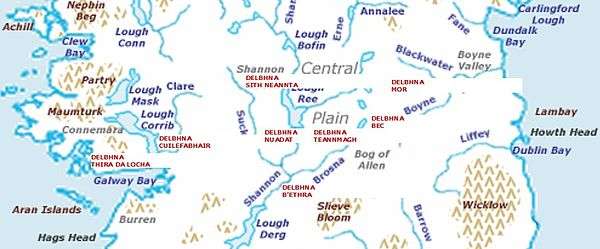Delbhna
The Delbna or Delbhna was a Gaelic Irish tribe in Ireland, claiming kinship with the Dál gCais, through descent from Dealbhna son of Cas. Originally one large population, they had a number of branches in Connacht, Meath, and Munster in Ireland.[1]

Early peoples and kingdoms of Ireland, c.800
Branches
- The Delbhna Tir Dha Locha (of the Two Lakes), or Delbhna Feadha (of the Heather), were based in the area of County Galway between Lough Corrib and Lough Lurgan/Galway Bay. Their chiefs took the surname MacConraoi, or MacConroy, later Anglicized to King. The MacConraoi held Gno Mor while their cadets, O'hEanna or O'Heney, held Gno Beg, but in the annals MacConraoi is always styled Ri or Tighearna Thira Da Locha.[2][3]
- The Delbhna Cuile Fabhair once held Maigh Seóla, the area east of Lough Corrib in County Galway, until conquered by the Uí Briuin Seola (who later became the Muintir Murchada, then the Ó Flaithbertaighs, who were in turn later driven into Connemara, where they became known as Kings of Iar Connacht). Their chiefs took the surname O'Fathairtaigh or Faherty.[4]
- The Delbhna Nuadat, or Delbhna Uí Maine, were lords of a large section that is now Athlone in County Roscommon, situated between the Suck and Shannon Rivers. From the early historic era they were a subject people of the Uí Maine. Their chiefs took the surname O'Flannagain or Flannagan.[5][6][7]
- The Delbhna bEthra may have once formed a single kingdom with the Delbhna Nuadat until subjugated by the Uí Maine. By the late 5th century they had fallen under the control of the Uí Néill. Their chiefs took the surname MacCochluinn or Coughlan, and their territory was what is now Garrycastle in County Offaly.[8]
- The Delbhna Mor were located in what is now Delvin in County Westmeath. Their chiefs took the surname O'Finnallain or Fenelon. They lived together with one of the seven branches of the Soghain.[9]
- The Delbhna Bheag, or Delbhna Bec, were based in what is now Demifore in County Westmeath. Their chiefs took the surname Ua Maoilchallan, or Mulholland.[10]
- The Delbhna Sith Neannta ruled over the area now called Fairymount in County Roscommon. Their chiefs took the name O'Laoghog or Logue.[11]
- The Delbhna Teannmhagh, or Delbhna Iarthair Mhidhe, at one time controlled what is now Rathconrath in County Westmeath. Their chiefs took the surname Ua Scolaidhe or O'Scully.[12][13]

Central Ireland showing the approximate location of the various branches of the Delbhna
According to their earliest legends, the Delbhna took their name from their ancestor Delbáeth, son of either Aengus or Ogma, a god of the Tuatha Dé Danann who succeeded The Dagda, or Eochaid Ollathair, as High King of Ireland and who for various reasons is identified as the same as Tuireann. A later story told that the Delbhna descend from Suman, son of Lugh Delbáeth, son of Cas, progenitor of the Dal gCais.[14]
gollark: If so, mankind is doomed.
gollark: Oh no. Has Macron begun?!
gollark: Oh dear.
gollark: I don't know what you mean; is it Macron, LyricLy?
gollark: Oh hypermemetic ultrabees of cryoapiocity class 112-γ.
See also
- Uí Fiachrach Aidhne
- Clann Fhergail
- Clann Taidg
- Senchineoil
- Trícha Máenmaige
- Uí Díarmata
- Cóiced Ol nEchmacht
- Síol Anmchadha
- Cenél Áeda na hEchtge
- Conmhaícne
References
- History of Ireland, Volume 8, page 297.
- "History of Ireland in Maps".
- The Book of Rights, page 105.
- "Library of Ireland".
- The dolmens of Ireland, page 1075.
- The Book of Rights, page 105.
- "Ireland History in Maps".
- "Ireland History in Maps".
- The dolmens of Ireland, page 1075.
- "Ireland History in Maps".
- The history of Ireland, page 297.
- Irish pedigrees, page 830.
- The dolmens of Ireland, page 1075.
- "Ireland History in Maps".
External links
This article is issued from Wikipedia. The text is licensed under Creative Commons - Attribution - Sharealike. Additional terms may apply for the media files.